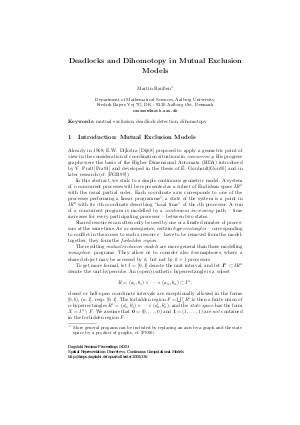Deadlocks and Dihomotopy in Mutual Exclusion Models
Author Martin Raussen
-
Part of:
Volume:
Dagstuhl Seminar Proceedings, Volume 4351
Part of: Series: Dagstuhl Seminar Proceedings (DagSemProc) - License:
 Creative Commons Attribution 4.0 International license
Creative Commons Attribution 4.0 International license
- Publication Date: 2005-04-22
File

PDF
DagSemProc.04351.12.pdf
- Filesize: 196 kB
- 8 pages
Document Identifiers
Subject Classification
Keywords
- Mutual exclusion
- deadlock detection
- dihomotopy
Metrics
- Access Statistics
-
Total Accesses (updated on a weekly basis)
0Document
0Metadata
Abstract
Parallel processes in concurrency theory can be modelled in a geometric framework. A convenient model are the Higher Dimensional Automata of V. Pratt and E. Goubault with cubical complexes as their mathematical description. More abstract models are given by (locally) partially ordered topological spaces, the directed ($d$-spaces) of M.Grandis and the flows of P. Gaucher. All models invite to use or modify ideas from algebraic topology, notably homotopy. In specific semaphore models for mutual exclusion, we have developed methods and algorithms that can detect deadlocks and unsafe regions and give information about essentially different schedules using higher dimensional ``geometric'' representations of the state space and executions (directed paths) along it.
Cite As Get BibTex
Martin Raussen. Deadlocks and Dihomotopy in Mutual Exclusion Models. In Spatial Representation: Discrete vs. Continuous Computational Models. Dagstuhl Seminar Proceedings, Volume 4351, pp. 1-8, Schloss Dagstuhl – Leibniz-Zentrum für Informatik (2005)
https://doi.org/10.4230/DagSemProc.04351.12
BibTex
@InProceedings{raussen:DagSemProc.04351.12,
author = {Raussen, Martin},
title = {{Deadlocks and Dihomotopy in Mutual Exclusion Models}},
booktitle = {Spatial Representation: Discrete vs. Continuous Computational Models},
pages = {1--8},
series = {Dagstuhl Seminar Proceedings (DagSemProc)},
ISSN = {1862-4405},
year = {2005},
volume = {4351},
editor = {Ralph Kopperman and Michael B. Smyth and Dieter Spreen and Julian Webster},
publisher = {Schloss Dagstuhl -- Leibniz-Zentrum f{\"u}r Informatik},
address = {Dagstuhl, Germany},
URL = {https://drops.dagstuhl.de/entities/document/10.4230/DagSemProc.04351.12},
URN = {urn:nbn:de:0030-drops-1364},
doi = {10.4230/DagSemProc.04351.12},
annote = {Keywords: Mutual exclusion , deadlock detection , dihomotopy}
}
